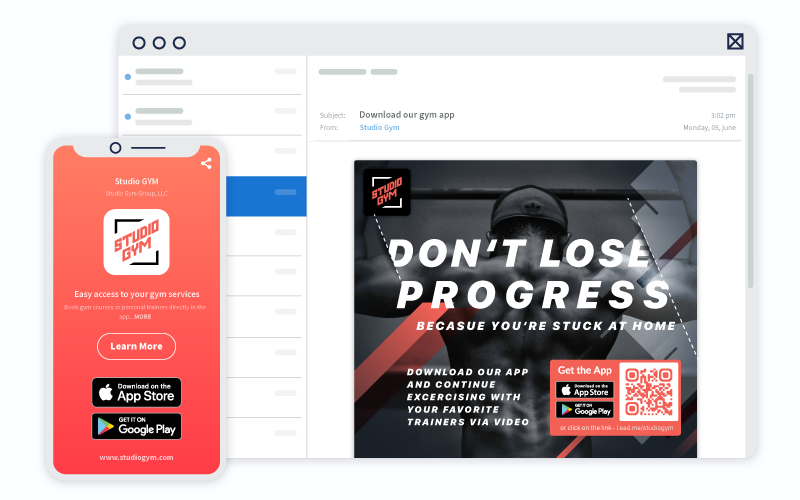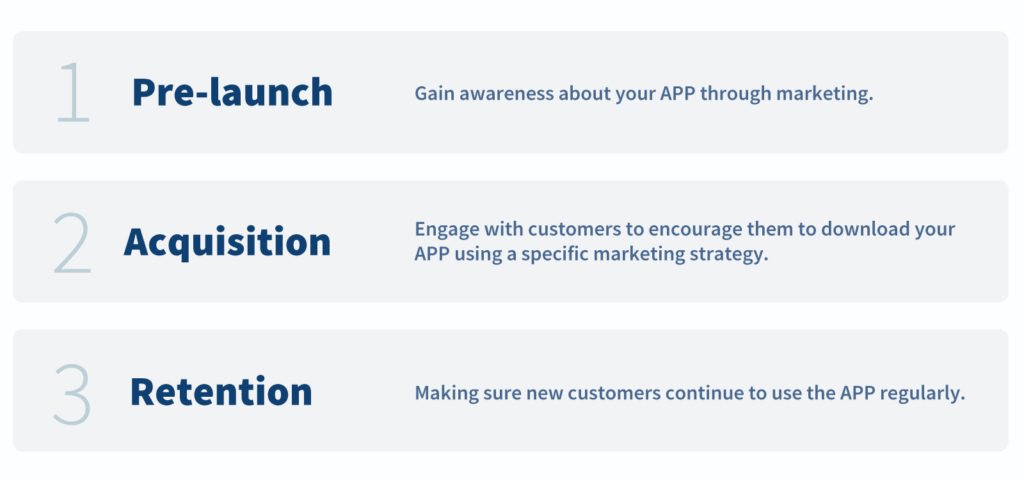- Best Practices ●
- COVID-19 ●
- Industry Trends ●
- Partners ●
- Product ●
What To Know About QR Code Marketing for Apps
Imagine hiring the best UI/UX design and app development teams, only for your app to fail. The truth is, this is a reality for some business owners. Why? Because many assume that developing a great app is enough to secure users.
While you may get lucky, success isn’t always guaranteed, especially if you don’t market your product.
Successful app marketing involves tracking campaign metrics, focusing on the correct target audience, creating app-related content, and tying all this up in a nice bow, using QR Codes to increase brand awareness.
QR Codes can be the difference between a few downloads and thousands or even millions of app downloads. Let’s take a look at how these innovations can elevate app marketing.
How can QR Code marketing help apps perform better?
It can be a costly false assumption to think that having an app in an app store is enough to become profitable. In reality, the reason why some apps have been so successful is the marketing behind them—and not just general marketing; it needs to be well-informed marketing using a specific strategy.
One way to escalate an app marketing strategy is by using an App Store QR Code. QR Codes can easily link to a wide range of digital content, including videos, images, web pages, apps, and more. Their square shape means they can hold mass amounts of data, which you can use in countless ways for marketing campaigns. And, with QR Code generator software, QR Codes are completely customizable, so they can help you maintain a consistent brand identity in your marketing efforts.
Another reason why QR Codes are particularly useful for app marketing campaigns is that they make app downloads easier for customers. With App QR Codes, it only takes a single scan for smartphone users to visit relevant app stores and initiate downloads.
Here’s a deeper look at how QR Codes can enhance your app marketing strategy:
Tracking metrics and editability
App QR Codes, along with all other types of Dynamic QR Codes, all include important tracking information. QR Code Generator simplifies the process of measuring the ROI (return on investment) of QR Code marketing campaigns because you can view real-time metrics such as location by country and city, time scanned, the operating system of the device used, and total vs. unique scans.
These metrics are beneficial for marketing apps because apps are often intended for global use or at least use in multiple countries. You can optimize conversion rates with QR Codes by comparing campaign success rates for different locations and times and using those insights to inform future marketing campaigns.
Medium versatility
Speaking of campaign comparisons, this isn’t just limited to different locations; it also includes different mediums. App QR Codes can be used on mobile web pages, desktop landing pages, email campaigns, social media pages, and even print ads. You can either compare the location scans of one QR Code or create multiple campaigns using different QR Codes separated by the type of marketing tool.
Customized designs
No matter what medium you’ve chosen for your QR Code, there are a myriad of customization options. You can design your QR Codes with custom frames, logos, edges, and colors. This makes aligning your QR Codes with your brand image easier and enhances recognizability. The more recognizable your QR Codes are, the more likely your audience is to scan them.
Clear-cut CTA (call to action)
An additional customization feature is the ability to include a CTA with your QR Code. The purpose of a CTA is to clarify the exact steps a customer should take to engage with you further. In the case of an app, a CTA with something like “Get the App” or “Scan and Download” is a great place to begin. Regardless of the medium, the CTA should include an active verb and consist of only a few words.

Better user experience
Mobile app marketing campaigns are often accompanied by a video trailer or images from the app. App QR Codes can direct users to a landing page displaying this information or link to the app directly.

Either way, providing easy access to this kind of information or the app itself can improve the user experience. With 79% of clients agreeing that the experience a brand offers is just as vital as its products, the need for high-quality customer experiences can’t be overstated.
How to incorporate QR Codes into the 3 stages of digital marketing for apps
There are three stages of mobile app marketing: pre-launch, acquisition, and retention. QR Codes can help you provide better customer experiences and streamline processes at each stage. Here’s a deeper look at how:

1. Pre-launch
The pre-launch stage aims to build up “noise” before the app launches. Boosting awareness before the app is complete will increase the success of all subsequent marketing efforts. It builds tension before the big reveal in the same way as the saying, “Drum roll, please.”
In this marketing stage, you should already have the brand values in mind and the type of message you want to convey with your marketing efforts. It’s a chance to connect with your target market early on and boost product visibility.
The pre-launch stages include elements such as:
- Determining a release date
- Conducting market research and creating user personas based on this
- Researching competitors
- Creating a website or other elements to showcase the app (images, video trailer)
- Developing outreach such as a press kit
- Social media marketing
- Content marketing: blogs, email marketing, landing pages.
QR Codes can enhance your pre-launch efforts by making it easy for you to share information and for your audience to receive it. For example, linking your codes to promotional videos or a “Coming Soon” page to tease your app’s launch makes sharing across multiple platforms easy and facilitates seamless information access.
If you use QR Codes for your pre-launch, add them to preliminary marketing materials like posters, social media posts, and email signatures, and share them with your target audience for maximum reach.
2. Acquisition
The acquisition stage is the time to put your marketing efforts into full force. You want to get as many downloads as possible in the first week after launching. The more downloads you have, the higher it will rank on the app stores. Consider strategies like paid social media ads, Google ads, and app store optimization (ASO) to inform potential users about your app.
Incorporate QR Codes into your marketing campaigns to make it easier for your target audience to download your app. Add the codes to social media posts, physical marketing materials like billboards, and influencer content to maximize your reach.
The beauty of running marketing campaigns with QR Codes is that they not only provide easy access to information but also offer tracking data. Regularly monitor your QR Code scans to identify the demographics most interested in your app. This way, you can optimize your marketing strategy to boost app downloads.
3. Retention
Marketing efforts don’t stop after the acquisition. Making sure those new customers remain is just as important—a 5% increase in customer retention correlates with at least a 25% increase in profit. Loyal customers often bring on new customers and continue to make their own purchases. Ways to increase customer retention for apps include:
- In-app notifications
- Push notifications
- Gathering customer reviews
- Referral bonuses
- Offering further purchase discounts (for example, via direct mail).
You can add QR Codes to your app to improve retention rates through better customer experiences and enhanced user engagement. For example, if you run a complex gaming app, you can embed QR Codes linked to tutorials at different stages within your app to help gamers play. To boost engagement, you can add QR Codes linked to exclusive content or in-game rewards.
QR Codes can also help improve your app and attract new customers. To improve your app, add Feedback QR Codes, asking your clients what they like about it and what they’d want you to do better. To attract new customers and re-engage satisfied ones, add QR Codes linked to review platforms or referral submission forms.
Essential strategies for successful mobile app marketing
Itching to get the show on the road with mobile app marketing? Here are some tips to guide your process and boost your chances of success:
Take research seriously
Spend a good deal of time doing research, both on your target markets and on your competitors. Proper research will help you tailor your marketing strategies appropriately, boosting your likelihood of success.
Through research, you can distinguish your USP (unique selling point) or the aspects of your product that separate you from your competitors, as well as create detailed user personas to inform your marketing campaign.
Understanding your USP makes it easier to connect with your target market and create the content and brand messages you want to convey during marketing campaigns. Creating user personas helps you understand your ideal customer, allowing you to make app improvements best suited for them and develop a marketing campaign that specifically targets them.
Use ASO
App store optimization (ASO), also known as app store SEO, involves improving your app’s ranking and visibility in app stores. The higher your ranking, the more likely people who browse these stores are to download your product.
The foundation of any ASO strategy is keyword research. Like search engines such as Google, app stores recommend apps that align with users’ search phrases first. So, research the words or phrases your target audience typically uses when searching for apps like yours and incorporate them into your title and description.
Also, add compelling visuals like app screenshots, a video trailer, or other images to showcase your app. Ensure they’re high-quality and accurately represent what potential customers should expect to boost downloads and encourage positive reviews.
Utilize influencer partnerships
If you’re an avid shopper, you probably already know the impact influencers have on purchasing decisions. Partner with influencers to reach broad audiences and boost your credibility—all they need to do is share your App Store QR Code on their social media profiles to allow their followers to download your app seamlessly.
For optimal results, work with influencers specializing in your niche. For example, you can partner with popular gamers if you’re a game developer. Similarly, if you’re in fashion, partner with fashion influencers—their followers are more likely to download your app than, say, a gamer’s followers.
Emphasize video content
Did you know that 52% of people are more likely to share video content than static content? This makes video content a must-have for your app marketing campaign if you want to reach customers beyond your immediate target market.
There are numerous video content ideas you can implement for your app marketing campaign, including:
- Creating an app trailer showing what customers can expect.
- Having customers share their app experiences. This is an excellent way to boost customer engagement.
- Recording yourself, employees, influencers, customers, and so on using your app. This is especially beneficial for gaming apps.
Share the videos on social media and embed QR Codes that link to them on offline marketing materials to reach as many people as possible.
Encourage user reviews (and promote engagement)
Some business owners stop marketing efforts after launching their apps. But, this is a mistake that can result in significant losses. Continue to market and engage with your customers even after securing your downloads to maintain user interest and app relevance.
One way to do so is by asking for user reviews. This is an excellent ASO strategy that can improve your visibility and trustworthiness, as well as boost user engagement.
Another way to engage with customers is to provide personalized experiences. For example, if you run a gaming app, you can give rewards for reaching specific game levels. You can also offer push notifications like special offers, app deals, or limited content.
Track KPIs
KPIs (key performance indicators) refer to the metrics used to understand the success of a marketing campaign so that you know how to make it more efficient. These metrics include:
- App downloads: Number of app downloads
- Daily active users (DAU): Number of people who use the app on a daily basis
- Monthly active users (MAU): Number of people who use the app on a monthly basis
- Stickiness rate: How likely a user is to change from a MAU to a DAU
- Daily sessions per DAU: How often a person uses the app throughout the day
- Retention rate: Percentage of users who come back to the app after the initial visit
- Churn ratio: Percentage of users who no longer use the app.
Which of these is the most useful or accurate for determining campaign success depends entirely on your marketing goals. For example, if your objective is to maximize app downloads, then app downloads should be your primary metric. For user retention, the retention rate and churn ratio are vital KPIs.
Regularly monitor your metrics to identify what works and what doesn’t. This can help you improve app performance and refine future marketing strategies.
Explore the benefits of QR Codes for mobile app marketing with QR Code Generator PRO
QR Codes can enhance your marketing efforts by making it easier for potential customers to download your app and facilitating seamless engagement. For optimal results, ensure your QR Codes align with your marketing goals and brand identity. Also, regularly monitor their performance and optimize your strategy based on their scan data.
With QR Code Generator PRO, you can experiment with different types of QR Codes until you find the ones most suitable for your app marketing strategy. You can access real-time performance metrics like the number of scans per location and device, allowing you to continuously refine your marketing campaigns.
Sign up for QR Code Generator PRO today to increase your app downloads, improve the user experience, and boost customer engagement with custom QR Codes.






 Add custom colors, logos and frames.
Add custom colors, logos and frames.
